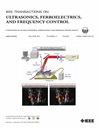基于压电微机械超声波悬臂的深度学习高精度机载测距仪。
IF 3
2区 工程技术
Q1 ACOUSTICS
IEEE transactions on ultrasonics, ferroelectrics, and frequency control
Pub Date : 2024-07-25
DOI:10.1109/TUFFC.2024.3433407
引用次数: 0
摘要
本文介绍了一种基于连续波压电微悬臂梁阵列的高精度空气耦合声波测距仪。通过设计定制阵列,利用悬臂创建了一个范围从 0 米到 1 米的功能性超声波测距仪。这项研究调查了利用超声波信号识别空中测距的各种分类技术。最初的方法包括实施单个模型,如支持向量机 (SVM)、高斯直观贝叶斯 (GNB)、逻辑回归 (LR)、k-最近邻 (kNN) 和决策树 (DT)。为了可能实现更好的性能,本研究引入了基于卷积神经网络(CNN)的深度学习(DL)架构,以对不同范围进行分类。CNN 模型结合了多种分类模型的优势,旨在实现更准确的范围检测。为确保该模型能很好地泛化到未见数据中,采用了一种称为 k 倍交叉验证的技术来提供可靠性评估。与其他方法相比,所提出的框架在准确率(100%)和 AUC(1.0)方面都有显著提高。本文章由计算机程序翻译,如有差异,请以英文原文为准。
High-Accuracy Airborne Rangefinder via Deep Learning Based on Piezoelectric Micromachined Ultrasonic Cantilevers
This article presents a high-accuracy air-coupled acoustic rangefinder based on piezoelectric microcantilever beam array using continuous waves. Cantilevers are used to create a functional ultrasonic rangefinder with a range of 0–1 m. This is achieved through a design of custom arrays. This research investigates various classification techniques to identify airborne ranges using ultrasonic signals. The initial approach involves implementing individual models such as support vector machine (SVM), Gaussian Naive Bayes (GNB), logistic regression (LR), k-nearest neighbors (KNNs), and decision tree (DT). To potentially achieve better performance, the study introduces a deep learning (DL) architecture based on convolutional neural networks (CNNs) to categorize different ranges. The CNN model combines the strengths of multiple classification models, aiming for more accurate range detection. To ensure the model generalizes well to unseen data, a technique called k-fold cross-validation (CV), which provides the reliability assessment, is used. The proposed framework demonstrates a significant improvement in accuracy (100%), and area under the curve (AUC) (1.0) over other approaches.
求助全文
通过发布文献求助,成功后即可免费获取论文全文。
去求助
来源期刊
CiteScore
7.70
自引率
16.70%
发文量
583
审稿时长
4.5 months
期刊介绍:
IEEE Transactions on Ultrasonics, Ferroelectrics and Frequency Control includes the theory, technology, materials, and applications relating to: (1) the generation, transmission, and detection of ultrasonic waves and related phenomena; (2) medical ultrasound, including hyperthermia, bioeffects, tissue characterization and imaging; (3) ferroelectric, piezoelectric, and piezomagnetic materials, including crystals, polycrystalline solids, films, polymers, and composites; (4) frequency control, timing and time distribution, including crystal oscillators and other means of classical frequency control, and atomic, molecular and laser frequency control standards. Areas of interest range from fundamental studies to the design and/or applications of devices and systems.

 求助内容:
求助内容: 应助结果提醒方式:
应助结果提醒方式:


